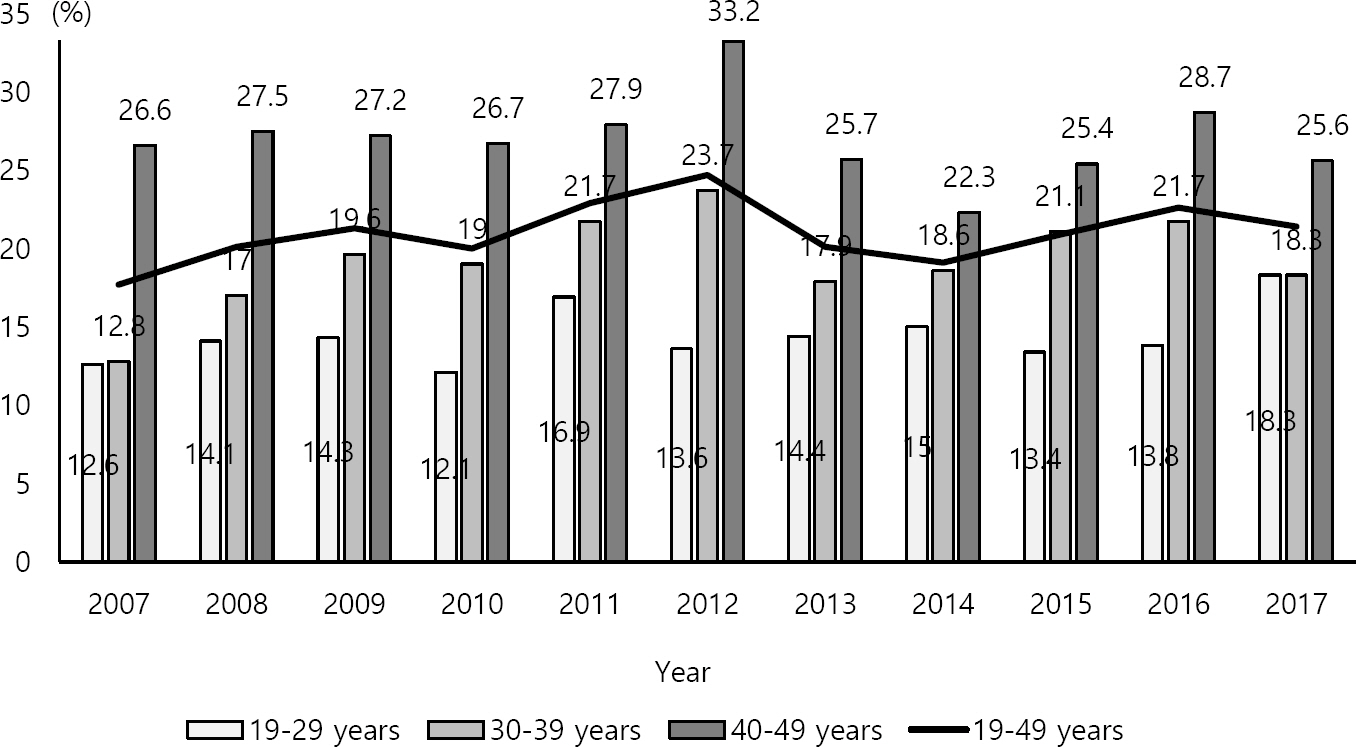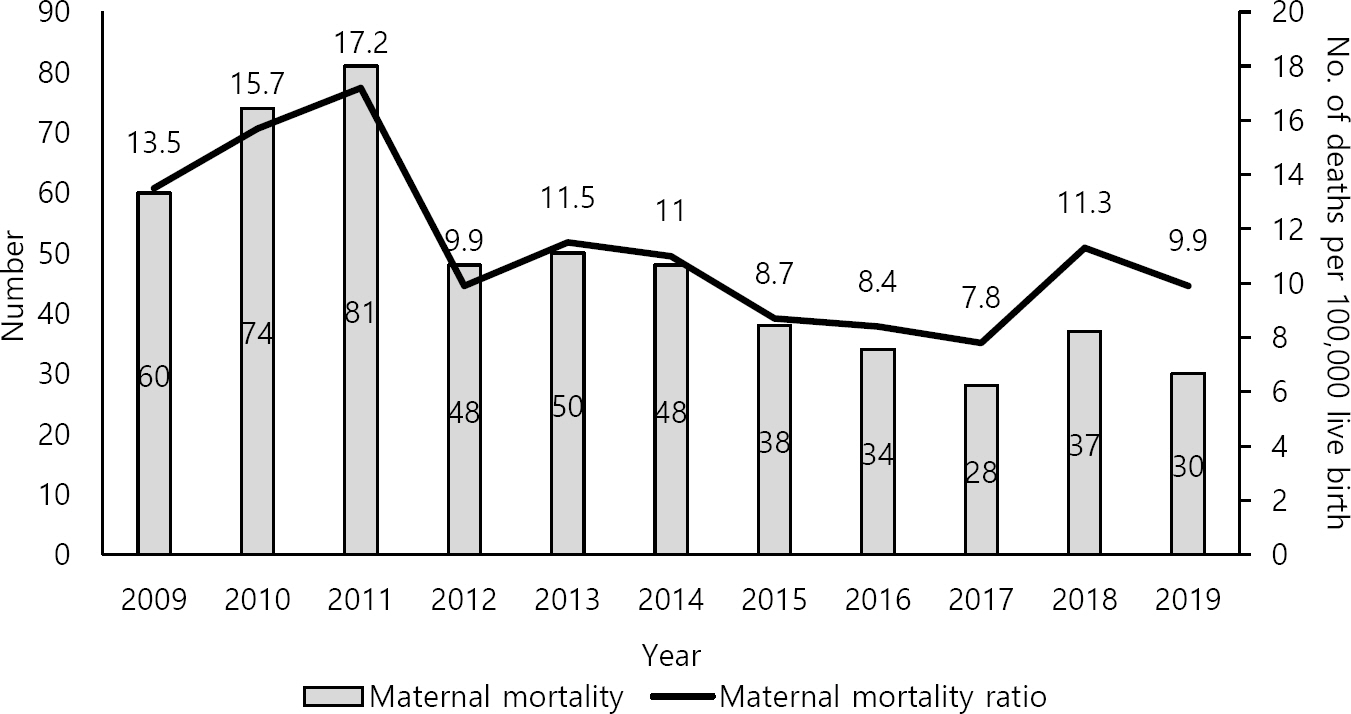J Korean Soc Matern Child Health.
2021 Jan;25(1):1-9. 10.21896/jksmch.2021.25.1.1.
Reproductive Health Rights and Indicators
- Affiliations
-
- 1Korea Institute for Health and Social Affairs, Sejong, Korea
- 2Department of Obstetrics and Gynecology, Samsung Medical Center, Sungkyunkwan University School of Medicine, Seoul, Korea
- 3Department of Obstetrics & Gynecology, Konkuk University Medical Center, Seoul, Korea
- KMID: 2512479
- DOI: http://doi.org/10.21896/jksmch.2021.25.1.1
Abstract
- This study aimed to review the definitions of reproductive health rights, investigate reproductive health status, and suggest policy strategies to promote reproductive health in Korea. Current laws, the Constitution of the World Health Organization, works from Guttmacher-Lancet Commission on Sexual and Reproductive Health and Rights, the Program of Action of the International Conference on Population Development, the Nairobi Statement on ICPD25, and the Convention on the Elimination of all Forms of Discrimination Against Women were reviewed to define reproductive health rights. The reproductive health status focusing on high-risk pregnancy was analyzed. Definitions of reproductive health rights include the right of every person to have lifetime access to the information, resources, services, and support needed to achieve bodily integrity, privacy and personal autonomy regarding their reproductive health. Most indices of reproductive health in Korea analyzed here are and would remain negative. Reproductive health should be approached from the perspectives of rights. We should continuously monitor the indicators of reproductive health and policies corresponding to low fertility rates in Korea should focus on improving women’s reproductive health. This suggests support for obstetrics and gynecology check-ups and treatments before pregnancy and postpartum care, the provision of education on the importance of prepregnancy health care for men and women and comprehensive information and counseling services. It is also necessary to establish a delivery infrastructure for safe pregnancy and childbirth and unify governmental ministries related to pregnancy and childbirth.
Figure
Cited by 1 articles
-
The effects of team-based learning on nursing students’ learning performance with a focus on high-risk pregnancy in Korea: a quasi-experimental study
Sunhee Lee, Hyun Jung Park
Korean J Women Health Nurs. 2021;27(4):388-397. doi: 10.4069/kjwhn.2021.11.16.
Reference
-
Baschat AA. Neurodevelopment after fetal growth restriction. Fetal Diagn Ther. 2014. 36:136–42.Boyer J. A time to lead: a roadmap for prgress on sexual and reproductive health and rights worldwide. Guttmacher Policy Rev. 2018. 21:35–40.De Jesus LC., Pappas A., Shankaran S., Li L., Das A., Bell EF, et al. Outcomes of small for gestational age infants born at <27 weeks' gestation. J Pediatr. 2013. 163:55–60.e1–3.Evans I. Reproductive health and human rights: integrating medicine, ethics, and law. J R Soc Med. 2004. 97:43–4.Ewertz M., Duffy SW., Adami HO., Kvale G., Lund E., Meirik O. Age at first birth, parity & risk of breast cancer: a meta-analysis of 8 studies from the Nordic countries. Int J Cancer. 1990. 46:597–603.Ha JY. The anachronism of criminal punishment for abortion: focusing on the international consensus on health rights-social rights-human rights practice. Healthcommune. 2017. 8:64–79.Jang YS. Suggestions for central mother and child medical center and perinatal medical delivery system. The Korean Society of Maternal and Child Health Spring Conference Book. 2019.Joo SH. Establishing an emergency maternal transport control center. J Korean Soc Matern Child Health. 2018. 22:1–6.Kang DS., Kim MG., Lee SY., Lee SL., Lee KH., Park MS, et al. Integrated policy measures for low fertility. Sejong (Korea): National Research Council for Economics, Humanities and Social Sciences;2020.Kim KC. A reproductive crisis in South Korea and the reconfiguration of its care regime. Korea Soc. 2020a. 21:161–89.Kim SH. From mother's obligation to reproductive rights: critical analysis of Mother and Child Health Act in South Korea. Ewha Gender Law. 2020b. 12:1–44.Koo YJ., Ryu HM., Yang JH., Lim JH., Lee JE., Kim MY, et al. Pregnancy outcomes according to increasing maternal age. Taiwan J Obstet Gynecol. 2012. 51:60–5.Lee JL., Ha EH., Eum JW. A study on the plan to promote the pregnant woman registration system for healthy childbirth and parenting. Seoul (Korea): Korea Institute of Child Care and Education;2018.Lee SY., Jang IS., Lee SS., Lee CH., Shin SM., Shin SH, et al. Population change and future social policy. Sejong (Korea): Korea Institute for Health and Social Affairs;2019.Lurie S., Piper I., Woliovitch I., Glezerman M. Age-related prevalence of sonographicaly confirmed uterine myomas. J Obstet Gynaecol. 2005. 25:42–4.Ministry of Health and Welfare. 2020 High-risk mothers and newborns integrated treatment center support project guidebook. Sejong (Korea): Ministry of Health and Welfare;2020.Ministry of Health and Welfare. National survey on postnatal care 2018. Sejong (Korea): Ministry of Health and Welfare;2019.Siva N. Nulliparity does not equal cancer. Lancet Oncol. 2007. 8:675.Starrs AM., Ezeh AC., Barker G., Basu A., Bertrand JT., Blum R, et al. Accelerate progress—sexual and reproductive health and rights for all: report of the Guttmacher-Lancet Commission. Lancet. 2018. 391:2642–92.Statistics Korea. Birth statistics of 2019. Daejeon (Korea): Statistics Korea;2020a.Statistics Korea. Cause of death statistics. Daejeon (Korea): Statistics Korea;2020b.
- Full Text Links
- Actions
-
Cited
- CITED
-
- Close
- Share
- Similar articles
-
- Decision-Making on Contraceptive Use among Women Living with Human Immunodeficiency Virus in Malaysia: A Qualitative Inquiry
- Development and Application of Sexual Rights Awareness Scale for Female Adults
- Development of Reproductive Health Program and Identification of Effect for Married Women Immigrants
- Reproductive Health
- Effects of Human Rights Sensitivity Program on the Human Rights Consciousness and Attitudes Toward the Mental Illness by Psychiatric Mental Health Nurses



